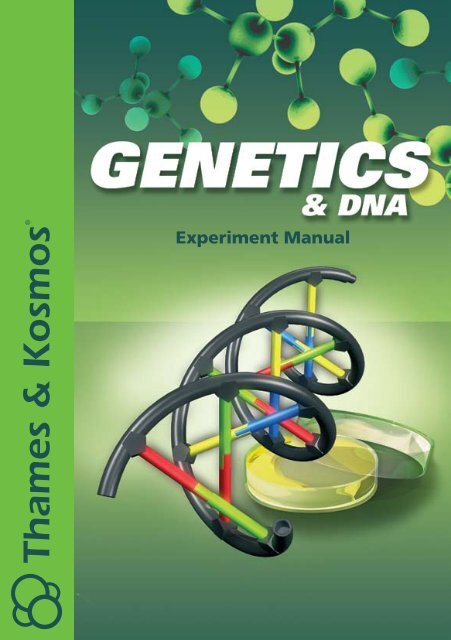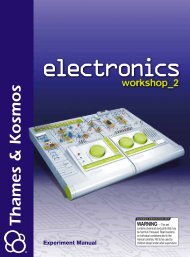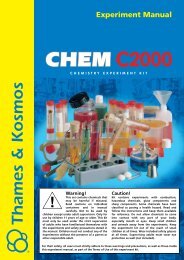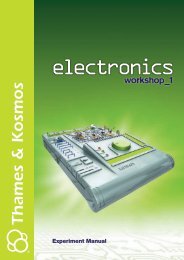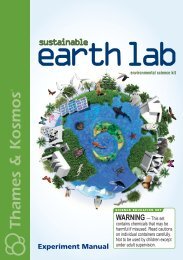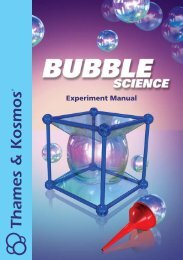Experiment Manual Sample Pages (PDF) - Thames & Kosmos
Experiment Manual Sample Pages (PDF) - Thames & Kosmos
Experiment Manual Sample Pages (PDF) - Thames & Kosmos
Create successful ePaper yourself
Turn your PDF publications into a flip-book with our unique Google optimized e-Paper software.
<strong>Experiment</strong> <strong>Manual</strong>
No. Description Part Part No.<br />
1 Empty brown glass bottle with lid 1 772 093<br />
2 Test tube with stopper 2 772 100<br />
3 Funnel 1 086 228<br />
4 Filter paper sheet 10 772 092<br />
5 Pipette 1 232 134<br />
6 Measuring cup 1 065 099<br />
7 Wooden skewer 1 020 042<br />
8 White and red plastic chips 12 each 705 818<br />
9 Inheritance worksheet 1 705 897<br />
10 Cell poster 1 705 820<br />
11 Chromosome puzzle and 1 705 819<br />
genetic fingerprinting cards<br />
12 DNA model 1 705 817<br />
13 Petri dish 2 702 184<br />
14 LB agar 2 705 815<br />
15 Lid opener 1 070 177<br />
16 Wooden spatula 1 000 239<br />
17 Safety goggles 1 052 297<br />
18 Red decoder film 1 161 415<br />
Also Required<br />
Denatured alcohol (methylated spirits), table<br />
salt, dish washing liquid, teaspoon, 2 yogurt<br />
containers, ruler, felt-tip pens, knife, scissors,<br />
permanent marker, plastic wrap, hand<br />
blender, tomato, jelly jar, microwave<br />
In each experiment, materials that<br />
are required but not included in the<br />
kit are written in cursive script.<br />
This red magnifying glass<br />
pops up over and over again<br />
in this manual. It shows where you<br />
can check your answer to a question<br />
by laying the red decoder film over<br />
the answer box.<br />
1
2<br />
GENETICS & DNA<br />
Table of Contents<br />
Kit Contents 1<br />
Notes for Parents and Adults 3<br />
Basic Rules for Safe <strong>Experiment</strong>ing 4<br />
1. Introduction 5<br />
2. Isolating Genetic Material 01 Let‘s get to work on the DNA... 7<br />
02 Further preparation for isolating DNA 8<br />
03 Isolating DNA – alcohol makes the DNA visible 9<br />
04 Retrieving the genetic material<br />
from the test tube 10<br />
05 Further experiments in isolating DNA 10<br />
3. On the Trail of Heredity 06 Relatedness makes an impression 12<br />
07 Mendel and the rules of heredity 13<br />
08 How features are passed on to offspring 16<br />
09 Why parents with brown eyes<br />
sometimes have blue-eyed children 17<br />
4. Cells: What Shapes Us... 10 The inner life of a cell 20<br />
5. Chromosomes 11 What chromosomes reveal 22<br />
12 The difference an extra chromosome can make 24<br />
6. Decoding the Structure of DNA 13 Building the backbone... 25<br />
14 ...and completing the DNA 27<br />
7. Heredity: Relaying the Code 15 Heredity in miniature 30<br />
16 Dividing chromosomes properly 32<br />
8. Cracking the Code 17 How many words can DNA make? 33<br />
9. Convicting the Perpetrators 18 The criminal profile 37<br />
10. The Age of Genetic Engineering 19 Preparing the growing medium for the bacteria42<br />
20 Cultivating bacteria 43<br />
11. Answers 46
These are the possibilities:<br />
a) If the programs complement each<br />
other equally, one program for red plus<br />
one for white would make pink flowers.<br />
This is what happens, for example, with<br />
the four o’clock flower, Mirabilis jalapa.<br />
One of these plants with a mixture of<br />
red and white programs does in fact<br />
have pink flowers.<br />
Pea<br />
Four o'clock flower (Mirabilis jalapa)<br />
Pea (Pisum sativum)<br />
Four o’clock flower<br />
b) But it is also possible for one program<br />
to dominate the other: for example, for<br />
the red program to prevail against the<br />
white program, so that the offspring<br />
plant has only red flowers even if both<br />
red and white programs are present.<br />
That is exactly how Mendel’s peas<br />
behaved.<br />
15
16<br />
GENETICS & DNA<br />
08 <strong>Experiment</strong><br />
How features are passed on<br />
to offspring<br />
The way that features were distributed<br />
was still unclear to Mendel. But on this<br />
topic, he had a few more ideas. After<br />
all his experiments, it suddenly became<br />
clear as day to him that each partner<br />
only passes on one copy of each program<br />
to the offspring and not all the<br />
copies. That makes sense, because otherwise<br />
the number of programs would<br />
double with each generation.<br />
Luckily, it is much more orderly than<br />
that: Only one of two possible programs<br />
passes from the parents to the children<br />
— so each of the offspring logically<br />
ends up with two copies again.<br />
Now we can explain which four combinations<br />
of the programs can arise from<br />
two different pea plants when they are<br />
crossed.<br />
These are the<br />
parent plants’<br />
programs.<br />
BRAIN TEASER:<br />
Suppose each of your<br />
grandparents has two programs<br />
to pass on. Each of them passes<br />
both programs on to your parents,<br />
and each of them in turn to you.<br />
If it worked this way, how many<br />
programs would you have?<br />
ANSWER:<br />
You will need:<br />
colored plastic chips<br />
Here’s how:<br />
a) One pea should have two programs<br />
for red, the other should have two for<br />
white. By placing the colored chips in<br />
the grid drawing, you can easily figure<br />
out all possible combinations.<br />
How it works:<br />
In each case, one program from one<br />
parent is crossed with one program<br />
from the other.<br />
possible<br />
combinations<br />
The X indicates that pea plant 1 (red-red) is crossed with pea plant 2 (white-white).<br />
From that crossing, we get four possible pea plant offspring, all with red flowers.


